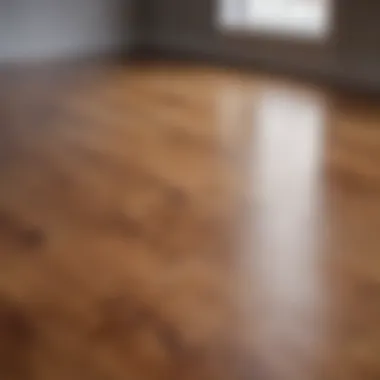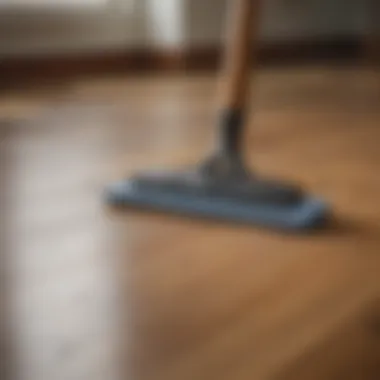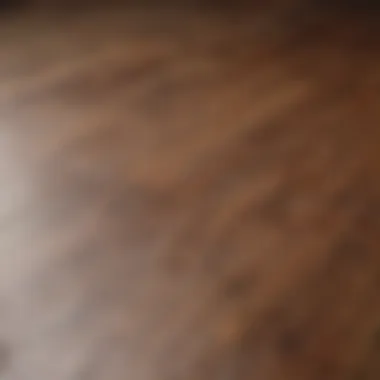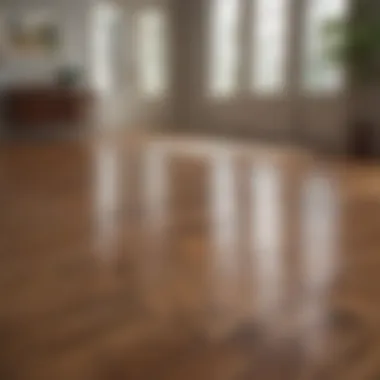The Essential Guide to Deep Cleaning Hardwood Floors


Intro
Deep cleaning hardwood floors is a vital task for homeowners who wish to maintain both the beauty and longevity of their flooring. Regular sweeping and mopping are not sufficient to tackle the dirt and grime that accumulate over time. This guide aims to cover various techniques, tools, and products that can effectively deep clean hardwood surfaces. By diving into pre-cleaning preparations, suitable cleaning solutions, and post-cleaning care, this article seeks to furnish homeowners and design enthusiasts with the knowledge necessary for optimal floor maintenance.
Importance of Deep Cleaning
Deep cleaning goes beyond surface-level care. It addresses the hidden dirt that can affect the aesthetics and durability of hardwood floors. The buildup can lead to scratches and dull the shine, making the floor appear old and worn. Regular deep cleaning ensures that these surfaces remain not only clean but also healthy.
Key points to consider when deep cleaning hardwood floors include:
- Understanding the type of finish on your floor.
- Choosing the right cleaning products based on the finish.
- Ensuring proper drying techniques to prevent water damage.
Thus, throughout this guide, we will unravel essential methods and expert tips that empower homeowners to preserve the striking allure and structural integrity of their hardwood floors.
Understanding Hardwood Floors
Understanding hardwood floors is key to maintaining their appeal and enhancing their longevity. These floors not only elevate the aesthetic of any space but also serve as an enduring investment for homeowners. Their ability to resist wear and age well is tied intrinsically to the knowledge one possesses about their characteristics, types, and signs of deterioration. Knowing what you have allows for tailored cleaning approaches, ensuring the flooring continues to shine and withstand daily use.
Characteristics of Hardwood Flooring
Hardwood flooring is unique in several ways. Its natural appeal is perhaps the most striking feature, offering a range of textures, grains, and colors that can complement various décor styles. Furthermore, hardwood floors have a certain resilience, known for their durability and ability to withstand heavy traffic when properly cared for.
The moisture resistance of solid hardwood varies and is a crucial factor in choosing the flooring. This can affect how you clean and maintain the floor, being especially pertinent in humid or moisture-prone areas. Some properties to note include:
- Natural Variability: Each plank is different, providing a bespoke feel.
- Longevity: With right maintenance, hardwood can last decades.
- Maintenance Requirements: Some species require more upkeep than others based on their finish and porosity.
Common Types of Hardwood
Different types of hardwood are available in the market, each with unique traits. Commonly used types include Oak, Maple, Cherry, and Walnut.
- Oak: Known for its strength and versatility, this wood is prominent in many homes. It often has a pronounced grain, adding character to the floor.
- Maple: Stronger and denser, maple offers a lighter color and subtle grain pattern.
- Cherry: This type darkens over time, creating a rich ambience. It is softer and may dent more easily.
- Walnut: A luxurious option with deep hues and varied grain patterns.
Choosing the right type impacts not just aesthetics but also the cleaning and maintenance regime. Each type reacts differently to cleaning solutions and techniques.
Signs of Wear and Tear
Regular inspection of hardwood floors is essential to detecting potential problems early. Common signs of wear include:
- Scratches and Scuff Marks: These often occur from foot traffic or furniture movement.
- Discoloration: Areas that appear faded or stained may denote moisture damage or sun exposure.
- Dents: These can arise from heavy objects being dropped or moved across the floor.
It is vital to address these issues promptly to prevent further damage. Lifting furniture correctly, choosing appropriate cleaning supplies, and being careful with footwear can minimize such wear. Regular checks and understanding wear signs will better prepare you for deep cleaning and maintenance needs.
Preparation for Deep Cleaning
Preparation is a crucial step when it comes to deep cleaning hardwood floors. The importance of this phase cannot be overstated as it sets the foundation for the entire cleaning process. A deep clean not only enhances the appearance of the floors but also prolongs their lifespan. The time invested in preparing your space can save you from potential damage and ensure the effectiveness of your cleaning efforts.
When preparing for deep cleaning, several specific elements need to be considered. Gathering necessary supplies, assessing the condition of your floors, and creating a cleaning schedule are all vital components. By taking these steps, you ensure that the cleaning process is efficient, effective, and tailored to the specific needs of your hardwood floors.
It is also essential to recognize that hardwood floors can have various types of finishes and conditions, which means preparation may vary based on the individual situation. Understanding your specific needs will aid in selecting the right tools and techniques for the job.
Gathering Necessary Supplies
Collecting the right supplies is the first step in the preparation process. The tools you will need for deep cleaning hardwood floors include a broom or vacuum, microfiber mop, buckets, and a few cleaning solutions. Using a vacuum cleaner that is specifically designed for hardwood is crucial to avoid scratches and damage. A soft bristle broom can be beneficial for collecting dust and debris from surfaces before the deeper clean.
Some suitable cleaning solutions might include:
- pH-balanced hardwood floor cleaner
- vinegar mixed with water to create a natural solution
- commercial cleaners designated for hardwood use


Ensure you have soft cloths and sponges available, as they are essential for applying your chosen solutions effectively. Additionally, make sure the mop you intend to use is suitable for hardwood to avoid moisture damage.
Assessing the Condition of Floors
Before any cleaning takes place, it's necessary to assess the condition of your hardwood floors. This assessment gives you insight into the areas that need extra attention or may require specialized treatment. Look for signs of wear and tear, such as scratches, dents, or discoloration. Addressing these problems before beginning the cleaning process can help in preserving the integrity of the wood.
When inspecting the floors, consider:
- Checking for loose boards or damaged areas that might need repair
- Noting any stains that may require specific cleaning methods
- Identifying any finish that may be wearing off and could need reapplication after cleaning
This step ensures that the cleaning approach is thorough and tailored to the unique needs of your flooring.
Creating a Cleaning Schedule
Establishing a cleaning schedule is fundamental to maintaining the beauty and durability of hardwood floors. A regular cleaning routine prevents dirt buildup and prolongs the life of the floors. Consider how often foot traffic occurs. High-traffic areas will require more frequent attention than less-used spaces in your home.
In your schedule, include:
- Daily tasks such as sweeping or vacuuming to remove debris
- Weekly duties like damp mopping with appropriate cleaners
- Monthly deep cleaning sessions to ensure comprehensive care
By structuring your cleaning tasks, you will establish good habits and ensure your hardwood floors remain in pristine condition. This schedule serves not only as a reminder but also as a strategy to prevent more extensive and costly cleaning efforts in the future.
Proper care and maintenance can extend the life of your hardwood floors significantly. Spending just a few minutes each day can lead to long-term benefits.
Choosing the Right Cleaning Solutions
Selecting the correct cleaning solutions is crucial for maintaining the beauty and integrity of hardwood floors. The solution you choose directly impacts the effectiveness of your deep cleaning process and the longevity of your flooring. Understanding the difference between various cleaning options allows homeowners to keep their floors in pristine condition while avoiding potential damage.
Commercial vs. Homemade Cleaners
When it comes to cleaning solutions, homeowners often find themselves weighing the merits of commercial products against homemade alternatives.
Commercial cleaners are formulated specifically for hardwood floors. They often come in a ready-to-use spray or concentrated formulas that can be diluted. These products typically contain proprietary blends designed to cut through grime and enhance shine. However, they may also include synthetic fragrances and preservatives, which some users prefer to avoid.
On the other hand, homemade cleaners offer a more natural approach. Common ingredients like vinegar, baking soda, and essential oils can create effective cleaning solutions that are less harsh. A popular mix involves equal parts water and white vinegar. This solution can clean without leaving harmful residues. However, users should note that vinegar should not be used frequently on all types of hardwood, as it can dull the finish over time.
Both options have their merits. It often comes down to personal preference, floor finish, and any allergies or sensitivities within the household.
Recommended Products
Several cleaning products have gained recognition for their effectiveness and safety. Some recommended options include:
- Bona Hardwood Floor Cleaner: Known for its residue-free formula, Bona is safe for all types of hardwood floors.
- Pledge Gentle Wood Floor Cleaner: This product not only cleans but also conditions the wood, enhancing the floor's natural beauty.
- Method Wood Floor Cleaner: This eco-conscious brand offers a plant-based cleaner that works efficiently without harmful chemicals.
For those choosing homemade solutions, ensure to use soft cloths or mops for application to avoid scratching the floor's surface.
Avoiding Harmful Ingredients
When selecting cleaning solutions, it is critical to avoid ingredients that can harm your hardwood floors. Some harmful substances include:
- Ammonia: Can break down the finish and cause the floor to lose its shine.
- Bleach: It can remove color and damage the wood’s fibers.
- Oils: While some oils are safe, others can create a slippery surface.
Additionally, it is advisable to read labels carefully and choose products that are free from these harsh chemicals. Prioritizing eco-friendly and non-toxic options ensures the safety of your floors and the environment.
"Choosing the right cleaning solution is as important as the cleaning technique itself. Damage from the wrong product can be irreversible."
Deep Cleaning Techniques


Deep cleaning hardwood floors is a critical component for maintaining their appearance and longevity. In this section, we will explore effective cleaning techniques tailored specifically for hardwood surfaces. Each method serves a unique purpose and offers various benefits, allowing homeowners to choose approaches that best fit their needs.
Using the right techniques not only ensures the surfaces are clean but also helps in protecting the wood from damage caused by improper cleaning methods. Keeping hardwood floors in optimal condition enhances their aesthetic appeal and prolongs their life. Below, we discuss three prominent techniques: dry cleaning, wet mopping, and spot cleaning specific stains.
Dry Cleaning Method
The dry cleaning method is a gentle yet effective way to remove surface dirt and dust from hardwood floors. This method is particularly suitable for floors in areas with less foot traffic or where moisture is a concern.
With dry cleaning, you can use a microfiber mop or cloth to attract and trap dust without the use of water or cleaning solutions. Here are some key points about this method:
- Minimal Moisture: Since it does not involve water, there is no risk of wood warping or swelling.
- Quick Process: It requires less time and can be done frequently without major disruption.
- Safety for Finish: It does not compromise the floor’s finish, making it ideal for newly finished and delicate floors.
This technique should be employed regularly, ideally every few days, to maintain a clean surface and prevent dirt from accumulating.
Wet Mopping Technique
The wet mopping technique is effective for a more thorough clean. It is vital, however, to approach this method with care to avoid damage to the hardwood. This technique uses water and appropriate cleaning solutions that are safe for hardwood floors.
Benefits of wet mopping include:
- Deep Cleaning: It removes more stubborn dirt and grime, providing a more intensive clean than dry methods.
- Enhanced Appearance: It leaves the floor looking fresh and polished.
- Sanitation: Wet mopping can help eliminate allergens and bacteria on the surface.
To execute this technique:
- Choose the Right Cleaner: Always opt for cleaners specifically formulated for hardwood floors. Avoid vinegar or ammonia-based cleaners as they can damage the finish.
- Mop Regularly: Wet mop every couple of weeks or as needed, depending on the level of dirt.
- Wring Out Mop: Ensure the mop is damp, not soaking wet, to prevent excess moisture on the floor.
By adhering to these principles, wet mopping can rejuvenate the look of your floors while maintaining their integrity.
Spot Cleaning Specific Stains
Despite regular cleaning, specific stains may require immediate attention to prevent lasting damage. Spot cleaning involves targeting those troublesome areas with precision. Here’s how to approach it:
- Identify the Stain: Determine the type of stain (e.g., food, pet urine, or ink) as different substances may require varied treatment methods.
- Use a Cleaning Solution: Apply a small amount of a hardwood-safe cleaning solution directly to the stain. Avoid scrubbing hard, as this can scratch the surface.
- Blot, Don’t Rub: Always blot with a soft cloth instead of rubbing, to avoid spreading the stain or damaging the finish.
- Follow Up: After spot cleaning, always dry the area with a separate clean cloth to avoid moisture damage.
"Addressing stains promptly is crucial to maintaining the visual appeal and integrity of your hardwood floors."
Post-Cleaning Maintenance
After completing the deep cleaning of hardwood floors, post-cleaning maintenance becomes crucial for preserving their appearance and longevity. Maintaining the integrity of your floors is not simply about cleaning; it is an ongoing process that ensures your hardwood remains in optimal condition. Neglecting this aspect can lead to premature wear and tear, diminishing the beauty and value of your flooring.
Applying Finish or Sealant
Applying a finish or sealant is one of the most vital steps in post-cleaning maintenance. This layer acts as a protective barrier against scratches, dirt, and moisture, which are common threats to hardwood floors. Depending on the wood type and your desired finish, options range from polyurethane to natural oils. The finishing process not only enhances the visual appeal of your floor but also extends its life by providing a shield against external elements.
When applying finish, ensure that the floor is completely dry and free of residues. Follow the manufacturer’s guidelines for application, including proper drying times and the number of coats required. This attention to detail is essential in achieving a durable and flawless finish.
Routine Inspection for Damage
Regularly inspecting your hardwood floors for any signs of damage is another significant aspect of post-cleaning maintenance. In time, even the best maintained floors can develop scratches, dents, or other forms of damage. Catching these issues early can save you from costly repairs later. Inspect your floors every few months for signs of wear, such as discoloration or peeling finish.
If you discover any problematic areas, address them promptly. Minor scratches can often be repaired with wood touch-up pens or a bit of polishing. For more serious issues, you may need to consult a professional to assess the situation and recommend appropriate interventions.
Establishing a Regular Cleaning Routine
Establishing a regular cleaning routine is essential for keeping hardwood floors in peak condition. This routine should include frequent sweeping or vacuuming to remove dust and debris that can cause scratches. Weekly damp mopping with a suitable cleaner helps maintain shine and cleanliness without damaging the finish.
Creating a schedule is beneficial. Set specific days for deep cleaning and adhere to regular upkeep. This habit prevents dirt accumulation and prolongs the life of the flooring.


"Routine care is not just preventative; it’s the foundation for a long-lasting, pristine hardwood floor."
Common Mistakes to Avoid
Deep cleaning hardwood floors is a nuanced task that requires careful consideration. Understanding and avoiding common mistakes can significantly affect the results of your cleaning efforts. Errors in the cleaning process can lead to damage, diminished appearance, and even increase maintenance costs. Hence, being aware of these pitfalls is crucial. Everything from inappropriate tools to neglecting the upkeep plays a significant role in flooring longevity. This section details key mistakes homeowners often make while deep cleaning their hardwood floors.
Using the Wrong Tools
Choosing the right tools for deep cleaning is essential. Using inappropriate tools can cause scratches, gouges, or even more severe damage to the flooring. For example, a vacuum cleaner with a beater bar is not suitable for hardwood floors. Instead, a vacuum designed specifically for hard surfaces or a broom with soft bristles is ideal.
The mop is another area where mistakes can occur. A traditional sponge mop can retain too much water, which is harmful to hardwood. Consider using a microfiber mop as it is effective at covering surfaces without excessive moisture. This choice protects the wood and ensures a thorough clean.
Ensure that all cleaning tools, including pads and brushes, are designed explicitly for hardwood. This approach ensures effective cleaning while minimizing the risk of damaging your flooring.
Over-Wetting the Surface
One of the most significant mistakes homeowners make is over-wetting the floor. Excess moisture seeps into the cracks and joints of the wood, leading to warping, swelling, or structural damage. Always start with a slightly damp mop instead of soaking the floor.
When wet mopping, use minimal water and follow up with a dry mop or towel to absorb any excess moisture. Moreover, ensure the room is well-ventilated during and after cleaning. This step will aid in quick drying and help prevent any potential damage due to lingering moisture.
"Using too much water is one of the fastest ways to ruin your hardwood floors. Remember, less is more when cleaning."
Neglecting Routine Care
Another critical mistake is neglecting routine maintenance. Deep cleaning should complement regular upkeep rather than replace it. Regular sweeping and dusting prevent dirt and grime buildup, which can scratch surfaces over time. It is advisable to sweep at least once a week, especially in high-traffic areas.
Additionally, consider applying a protective finish every few years depending on the wear and tear. This preventive measure can prolong the life of your floors significantly. Routine checks for minor scratches or damage allow for early repairs, preventing larger issues in the future.
Eco-Friendly Deep Cleaning Options
In recent years, there has been a significant shift towards eco-friendly practices across various facets of everyday life. This trend has reached deep cleaning methods for hardwood floors, where many people are seeking safer, sustainable options. Eco-friendly deep cleaning not only protects the environment but also contributes to indoor air quality and the health of those living in the space. By using biodegradable and natural cleaning products, homeowners can ensure that their cleaning efforts are not just effective, but also beneficial for the planet.
Biodegradable Cleaning Products
Biodegradable cleaning products have gained traction in the market due to their ability to break down into non-toxic components. These products typically do not contain harsh chemicals that might linger in the environment. Using biodegradable cleaners makes a positive impact on the ecosystem, promoting sustainability while maintaining cleanliness.
Some common biodegradable options include:
- Vinegar-based cleaners, known for their deodorizing and disinfecting properties.
- Castile soap, which is gentle yet effective in cutting through grime.
- Baking soda, an excellent abrasive that helps remove tough stains without scratching hardwood.
- Cornstarch, useful for removing pet stains or as a natural dusting agent.
When selecting biodegradable products, it's essential to check the labels to confirm their environmental claims. Using these products ensures less environmental pollution and is usually safer for children and pets in the home.
Natural Cleaning Solutions
Natural cleaning solutions offer another layer of eco-friendly options for maintaining hardwood floors. These solutions are often made from common household ingredients, which can be both economical and effective. Many homeowners prefer natural cleaning solutions because they are free from synthetic fragrances and preservatives.
Some popular natural cleaning solutions include:
- White vinegar mixed with water, an effective cleaner and deodorizer.
- Essential oils, such as lemon or tea tree, provide a pleasant scent while offering antibacterial properties.
- Olive oil can be used as a natural polish, helping to restore shine to the wood.
These natural solutions can be made at home, allowing for greater control over the ingredients used and reducing reliance on commercial products. However, it is crucial to conduct a patch test on a small area of the floor to ensure compatibility with the specific wood finish.
Maintaining a clean hardwood floor through eco-friendly options benefits both the environment and the occupants of the home, promoting a healthier living space.
End
The conclusion of this guide is essential for reinforcing the importance of maintaining hardwood floors through deep cleaning. Homeowners and interior design enthusiasts will find that a well-cared-for hardwood floor not only enhances the aesthetic of a room but also significantly extends the life of the flooring. The continual exposure to dirt, dust, and other contaminants can lead to irreversible damage if not addressed timely. Therefore, understanding how to effectively deep clean these surfaces is a crucial skill for any responsible homeowner.
Summary of Best Practices
To summarize the best practices for deep cleaning hardwood floors, the following points should be carefully noted:
- Understand your flooring: Identify the type of hardwood you have, whether it's solid or engineered, to choose suitable cleaning methods.
- Proper cleaning tools: Always use tools specifically designed for hardwood floors, such as microfiber mops, to avoid scratches or damage.
- Choose the right cleaners: Avoid harsh chemicals. Look for biodegradable or homemade cleaners that effectively clean without harming the finish of the wood.
- Regular maintenance: Establish a routine maintenance schedule to prevent the accumulation of dirt and grime. Frequent light sweeping can reduce the need for deep cleaning.
- Avoid excessive moisture: Use slightly damp mops rather than soaking wet ones. Excessive water can lead to warping and mold growth.
- Protect from scratches: Use rugs or mats in high-traffic areas and attach felt pads under furniture to minimize damage.
By implementing these best practices, homeowners can ensure their hardwood floors remain not only visually appealing but also structurally sound for many years to come.







